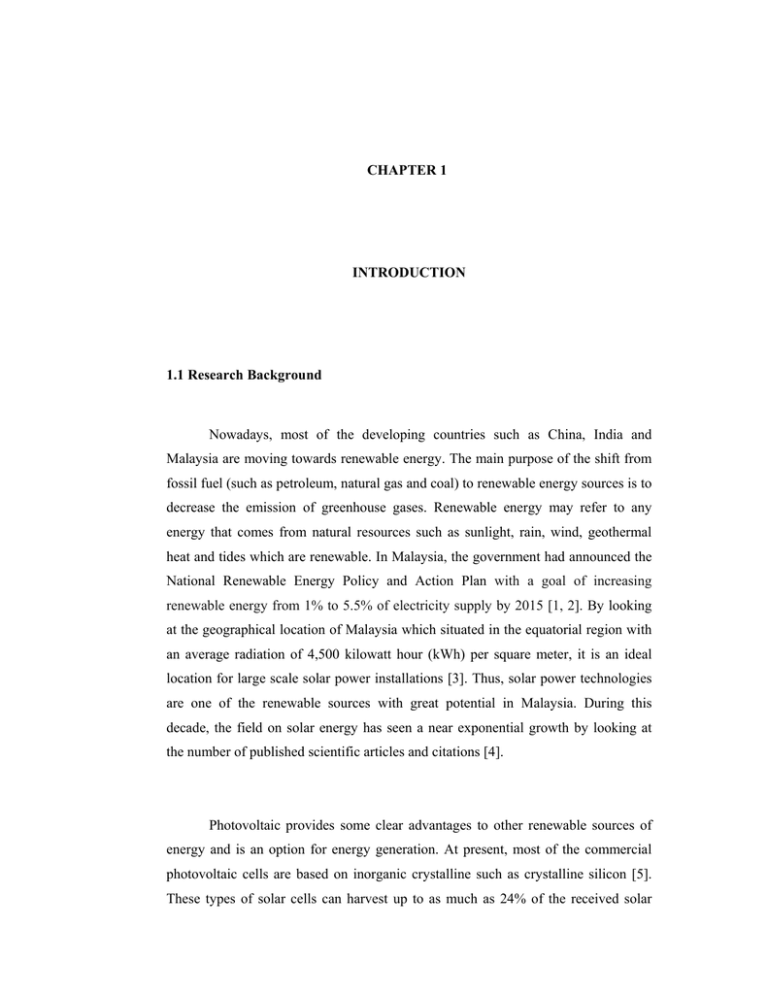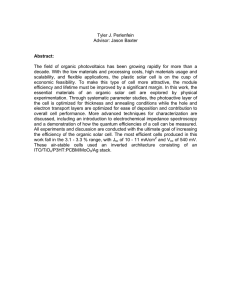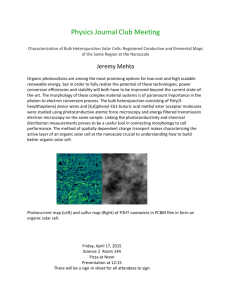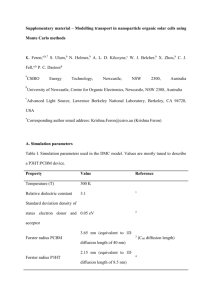Nowadays, most of the developing countries such as China, India... Malaysia are moving towards renewable energy. The main purpose of... CHAPTER 1
advertisement

CHAPTER 1 INTRODUCTION 1.1 Research Background Nowadays, most of the developing countries such as China, India and Malaysia are moving towards renewable energy. The main purpose of the shift from fossil fuel (such as petroleum, natural gas and coal) to renewable energy sources is to decrease the emission of greenhouse gases. Renewable energy may refer to any energy that comes from natural resources such as sunlight, rain, wind, geothermal heat and tides which are renewable. In Malaysia, the government had announced the National Renewable Energy Policy and Action Plan with a goal of increasing renewable energy from 1% to 5.5% of electricity supply by 2015 [1, 2]. By looking at the geographical location of Malaysia which situated in the equatorial region with an average radiation of 4,500 kilowatt hour (kWh) per square meter, it is an ideal location for large scale solar power installations [3]. Thus, solar power technologies are one of the renewable sources with great potential in Malaysia. During this decade, the field on solar energy has seen a near exponential growth by looking at the number of published scientific articles and citations [4]. Photovoltaic provides some clear advantages to other renewable sources of energy and is an option for energy generation. At present, most of the commercial photovoltaic cells are based on inorganic crystalline such as crystalline silicon [5]. These types of solar cells can harvest up to as much as 24% of the received solar 2 energy and this value is very close to the theoretically predicted upper limit of 30% [6]. However, the production of these solar cells still requires many energy intensive processes at high temperatures (400-1400ºC) and high vacuum conditions with numerous lithographic steps leading to relatively high manufacturing costs [6]. This demonstrates that the technologies which allow low fabrication costs with acceptable conversion efficiencies (up to 10% power conversion efficiency) are now desired. Polymer solar cells (PSC) have potential advantages such as low manufacturing cost, light-weight and flexibility [7]. Based on these advantages, a lot of researches on polymer solar cells have been conducted to make this type of solar cell competitive as the photovoltaic technology [8-10]. Bulk heterojunction (BHJ) structure which consists of the intermixing of a conjugated polymer and fullerene in blend films has brought about a significant enhancement of the dissociation interface, leading to high power conversion efficiency (PCE) up to 6% [11, 12]. Based on the performance that has been showed by BHJ PSC, extensive research has been conducted in these types of solar cells concentrating on the various process parameters that affects its performance such as the blending ratio of donor and acceptor materials, processing conditions and annealing conditions [11, 13]. 1.2 Problem Statement Normally, polymer solar cells (PSC) consists of binary blends of electrondonor material and electron acceptor material (D: A). Most of the current researches in binary blends PSC focusing on the polymer: fullerene blends due to their impressive performance in photovoltaic efficiency. Among the reported PSC systems in the literature, the poly (3-hexylthiophene) (P3HT): phenyl-C61-butyric acid methyl ester (PCBM) systems currently represent the state-of-art in PSC [14]. New devices structure such as tandem structure [15-18] and ternary blends PSC [1921] have also been developed to further enhance the performance and stability of PSC. 3 Ternary blends active layer consists of two electron-donor polymer and one electron-acceptor polymer (D1: D2: A) or one electron-donor polymer and two electron-acceptor polymer (D: A1:A2) have been recognized as an efficient strategy to further enhance efficiency and/or enhanced stability of the polymer bulk heterojunction (BHJ) solar cells [22]. This approach may lead to the optimization of both short circuit current (Isc) and open circuit voltage (Voc) through proper choice of the materials. This method is interesting since it does not involve complex design and fabrication as tandem cell approach [23]. Somehow, it is quite surprising that there are limited published results focused on ternary blend active layer particularly by adding an additional electron donor or electron acceptor in polymer: fullerene systems. Based on the extensive literature review, it can be seen that one of the critical parameters to achieve efficient devices is the morphology of the active layer of BHJ thin films. Kim et al. [19] added an additional electron donor, MDMO-PPV to P3HT:F8BT systems which has higher highest occupied molecular orbital (HOMO) level than P3HT. They observed a very low PCE which attributed to charge blocking resistance that exist in the bulk phase of ternary blends. They suggested that the performance of the ternary blend solar cells can be further improved by controlling the morphology of the active layer via thermal or electrical approach. Machui et al. [24] introduced an amorphous polymer, PCPDTBT to a P3HT:PCBM blend and observed a dramatic reduction of device efficiency due to the deterioration of electron transport in the ternary system [24]. Khlyabich et al. [23] study the influence of polymer miscibility on the open-circuit voltage (Voc) in ternary blend BHJ solar cells. They found that the miscibility of polymers had a major impact on the evolution of the Voc. Different ternary blends systems will produce different morphology depending on the types of materials used, donor to acceptor ratio, solvent, postdeposition treatment and the processing of the thin films or devices. Nevertheless, the morphology formations of such ternary system are generally not well 4 documented and understood. To date, different approach has been taken by previous researchers to produce nano-scaled interpenetrating networks within the whole active layer to ensure efficient exciton dissociation and charge transport [25]. The methods that have been previously applied by the researchers to control morphology are by adding the processing additives [25, 26], thermal annealing at specific temperature [27-29], and controlling the solvent evaporation rate [30]. By considering the current issues in ternary blend systems, the study conducted in this work focuses on the modification of the morphology of the active layer by implementing the solvent annealing with subsequent thermal annealing treatment. Both treatments are proven efficient in optimizing the phase separation between donor and acceptor materials [27]. For the first times, poly (2,5-dihexyloxy1,4-phenylenevinylene) (PDHeOPV) was used as an additional electron donor in poly (3-hexylthiophene) (P3HT): phenyl-C61-butyric acid methyl ester (PCBM) binary blends systems. It is worthy to describe the effects of PDHeOPV weight ratio on the photo physical, morphological, optical and crystalline properties of the ternary blends thin films. In addition, the understanding on the effects of ternary blends and thermal annealing towards the photovoltaic properties of polymer solar cells devices is crucial. 1.3 Objectives of the Study The objectives of this study are: 1) To prepare and characterize the spray coated ternary blend P3HT: PDHeOPV: PCBM thin films in terms of photo physical, morphological and optical properties. 5 2) To investigate the influence of P3HT: PDHeOPV: PCBM weight ratio on the spray coated ternary blend films in terms of photo physical, morphological and optical properties. 3) To study the effects of solvent annealing and thermal annealing on the photo physical, optical and morphological properties of the P3HT: PDHeOPV: PCBM ternary blends systems. 4) To fabricate the inverted ternary blends of P3HT: PDHeOPV: PCBM as an active layer in polymer solar cell devices 1.4 Scopes of the Study In order to achieve the above objectives, few scopes have been drawn. i. Conducting a preliminary study to obtain the optimum spray deposition time by varying the spray deposition time from 10s to 20s to fabricate the P3HT: PCBM thin films. Substrate to nozzle distance and air pressure were set at 7 cm and 1 bar, respectively. ii. Characterizing the spray coated thin films using optical microscope, atomic force microscope (AFM) and UV-Vis spectrophotometer. iii. Fabricating P3HT: PDHeOPV: PCBM bulk heterojunction (BHJ) thin films using spray coating method with different PDHeOPV weight ratio (0.5-2). iv. Characterizing the fabricated ternary blend thin films using differential scanning calorimeter (DSC), UV-Vis spectrophotometer, atomic force microscope (AFM), X-ray diffractometer (XRD), and photoluminescence (PL) spectroscope. 6 v. Performing post-deposition treatment (solvent annealing and thermal annealing) on the P3HT: PDHeOPV: PCBM thin films by varying the thermal annealing temperature from 130 °C- 150 °C. The solvent annealing treatment was done inside a petri dish for 15 min. The thermal annealing time were kept constant at 10 min. vi. Characterizing the annealed thin films using UV-Vis spectrophotometer, AFM, XRD and PL spectroscope. vii. Identifying the optimum P3HT: PDHeOPV: PCBM weight ratio in ternary blends under post-deposition treatment in order to produce the ideal thin films in active layer of polymer solar cells. viii. Fabricating the ternary blend polymer solar cells in inverted structure. The inverted structure used for this study was ITO/TiOx/P3HT: PDHeOPV: PCBM/PEDOT: PSS/PTE/Au. ix. Investigating the photovoltaic performance of the inverted devices using semiconductor characterization systems. Devices illuminated by xenon lamp as the light source at an irradiation intensity of 100mW/cm2 and air mass 1.5 filters (AM 1.5). x. Investigating the effect of continuous illumination to inverted devices performance. The light illumination times are varied from 0-120 min and the Isc and Voc values were obtained for every 30 min. 1.5 Significance of the Study This study is expected to provide a better understanding on the relationship between physicochemical properties (e.g. crystallinity, roughness, optical) and performance of the PSC, hereby improving the device performance by finer 7 controlling the thin film morphology. It is known that the blend morphology can be controlled through post-deposition treatments such as thermal annealing and solvent annealing. These treatments are able to increase the relative crystallinity of the blend phases and consequently resulting in enhancing optical properties and transport properties. Thus, attempts are made to investigate the optimum post-deposition parameter for the formation of thin film in active layer of PSC. To the best of my knowledge, there is no published researches investigate on the effect of solvent annealing with subsequent thermal annealing to the photo physical, morphological, optical, crystalline properties and photovoltaic properties of ternary blends films, particularly by using PDHeOPV as an additional electron donor in P3HT:PCBM systems. The effect of illumination time on the photovoltaic properties of ternary blend devices which is rarely reported is also investigated in this study. The findings of this study are important to discover the mechanism of the annealing treatment in the molecular level. The outputs of this study have the potentials for developing PSC with enhanced PCE and are useful for future studies towards commercialization of PSC technologies. 1.6 Organization of the Thesis The thesis consists of 8 chapters. Chapter 1 outlines brief information on the polymer solar cells and its current issues that leads us to conduct this research. The objectives, scopes and the significance of this study also been highlighted in this chapter. In Chapter 2, detailed information on the types of polymer solar cells, its operational principles and previous research on enhancing the PSC performance and stability were elaborated. Additionally, the method that has been employed by previous researchers to fabricate PSC is also discussed. Chapter 3 focuses on the experimental methods and characterization techniques that were used during this study. 8 Results and discussion were deliberated in Chapter 4 - Chapter 7. Chapter 4 describes in detail the effects of spray deposition time on the optical and morphological properties of P3HT: PCBM thin films. The spray deposition times were varied from 10s, 15s and 20s. The optimum deposition time were selected and were used to fabricate the thin film in Chapter 5. Chapter 5 discusses on the effect of P3HT: PDHeOPV: PCBM weight ratio on the optical and morphological properties of the thin films. The miscibility of the blends with the PDHeOPV weight ratio variation was investigated using differential scanning calorimeter (DSC). The effects of solvent annealing and thermal annealing on the optical, morphological and crystallinity properties of the blends films are addressed in Chapter 6. The obtained properties were analysed and the best weight ratio of P3HT: PDHeOPV: PCBM were chosen to fabricate the PSC devices in Chapter 7. In Chapter 7, the dependence of the performance of ternary blends polymer solar cells on thermal annealing temperature is addressed. The effects of continuous illumination on the photovoltaic properties of inverted devices were examined by exposing the devices under continuous illumination for 120min. Finally, the general conclusions of this study and some recommendation for future work were listed in Chapter 8.


